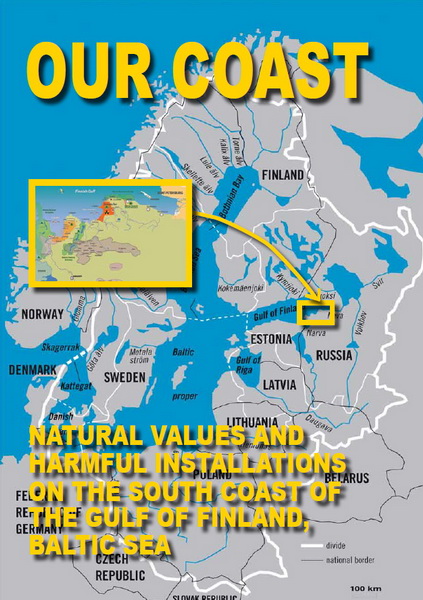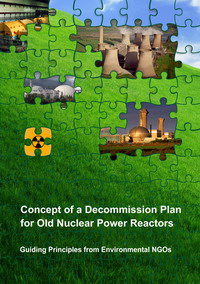
 |
The South Coast of the Gulf of Finland |
|---|---|
| Natural Values and Harmful Installations |
 |
Concept of a decommission plan for old nuclear power reactors |
|---|---|
| Guiding Principles from Environmental NGOs |
2. Energy scenarios in the Republic Belarus
2.1. Nuclear Scenario
In Belarus construction of power station using nuclear fuel was started in 1983, when in the vicinity of Minsk erection of the Minsk Nuclear Power Plant began. Its ca-pacity should have reached 2,000 MW. Simultaneously consideration of the issue of con-struction of the second – Belarusian Nuclear Power Plant has started. After 1986 con-struction of Nuclear Power Plant was stopped and Minsk Thermal Power Plant No 5 has been constructed on the basis of Minsk Nuclear Power Plant, 70% of which had been completed by 1986.
In 1992, after USSR collapsed, the Government of Belarus had approved the pro-gram of development of energy sector and power supply till 2010. For the first time after accident at the Chernobyl Nuclear Power Plant in it a separate item had been stipulated an opportunity to build a Nuclear Power Plant in territory of Belarus.
The Resolution of Chairperson of the Republic of Belarus Council of Ministers, adopted on 31 March 1998 has led to creation of the Commission on Evaluation of Expe-diency of Development in Nuclear Engineering in Belarus. The commission consisted of 34 persons, and was headed by the Vice-President of the National Academy of Sciences, Mr. P. A. Vityaz. Having discussed the problem and ways of its solving, the majority of the commission`s members arrived at the following conclusion:
In 2008 leadership of the Republic of Belarus has returned to consideration of an opportunity to build nuclear power plant and on 31 January 2008 the Republic of Belarus Security Council has taken a political decision to build nuclear power plant in Belarus.
State Commission in charge of choosing a place of location of area to build an NPP in Belarus on 20 December 2008 has decided that nuclear power plant will be erected at Ostrovetskaya site in the Grodno Region. Minutes of the meeting of the State Commission and certificate of choosing the place of location of area to build a nuclear power plant were signed. The choice has been based on results of studying three areas: Ostrovetskaya in the Grodno Region, Kranopolyanskaya and Kukshinovskaya sites – in Chaussky and Shklovsky districts of the Mogilyov Region.
2.1.1. Description of Nuclear Scenario
In conformity with the scenario, in 2015 the first unit of the nuclear power plant and by 2020 the second power unit should be commissioned .
Based on calculations, made by the Republic of Belarus National Academy of Sci-ences, commissioning of nuclear power plant with total capacity of 2,000 MW into power supply system of the republic during 2016-2018 will provide for stabilization of cost of production of electric power in Belarus at the level of US$ 0.13 per kWh during 2025-2030, whereas with “gas” option of developing power supply system the costs will rise to the level of US$ 0.18 per kWh in 2025 and US$ 0.21 kWh in 2030.
![Figure 8 - Expected costs for generation of electric power [21] Figure 8 - Expected costs for generation of electric power [21]](http://greenworld.org.ru/sites/default/greenfiles/images/fig08.jpg) Figure 8 - Expected costs for generation of electric power [21]
Figure 8 - Expected costs for generation of electric power [21]
Authors [21] link reduction of tariffs with commissioning of the NPP first power generation unit.
Nuclear generation shall replace natural gas in the amount of 5 million tons of fuel equivalent. By 2020 the share of nuclear generation in total balance of fuel and heating oil will make 16%, in generation of electric power it would reach approximately 30-32%.
Table 3 - Forecast of structure of consumption of fuel and heating oil by 2020, based on scenarios of development with and without of NPP (in mln. tons of coal equivalent), based on state program of modernization of fixed assets 2005 [2]
| Types of energy resources | Years | |||||
|---|---|---|---|---|---|---|
| 2005 | 2010 | 2015 | 2020 | |||
| With NPP | Without NPP | With NPP | Without NPP | |||
| Natural gas | 22,8 | 22,7 | 23,01 | 20,51 | 24,23 | 19,23 |
| Including as raw materials | 1,46 | 2,2 | 3,0 | 3,0 | 3,0 | 3,0 |
| Fuel oil | 1,6 | 1,55 | 1,6 | 1,6 | 1,4 | 1,4 |
| Coal | 0,15 | 0,2 | 0,2 | 0,2 | 0,2 | 0,2 |
| Liquefied gas | 0,33 | 0,3 | 0,32 | 0,32 | 0,2 | 0,2 |
| Gas generated by Oil refineries | 0,45 | 0,45 | 0,45 | 0,45 | 0,45 | 0,45 |
| Domestic heating oil | 0,11 | 0,09 | 0,12 | 0,12 | 0,1 | 0,1 |
| Local and other | 2,56 | 4,11 | 5,75 | 5,75 | 6,3 | 6,3 |
| Including: | ||||||
| Peat and lignin | 0,75 | 1,18 | 1,3 | 1,3 | 1,4 | 1,4 |
| Wood fuel | 1,18 | 2,24 | 3,2 | 3,2 | 3,5 | 3,5 |
| Other types, including hydropower plants | 0,62 | 0,69 | 1,25 | 1,25 | 1,4 | 1,4 |
| Nuclear fuel | 2,5 | 5 | ||||
| Total | 28,0 | 29,4 | 31,45 | 31,45 | 32,88 | 32,88 |
| Purchased electric power | 1,54 | 1,4 | 1,26 | 1,26 | 1,12 | 1,12 |
| Total: | 29,54 | 30,8 | 32,71 | 32,71 | 34,0 | 34,0 |
Therefore, by 2020 pure growth of consumption of primary fuel and energy re-sources should make about 3.34 mln. tons of coal equivalent fuel (taking no account of natural gas as raw material and import of the electric power). This growth should occur due to local resources, basically peat, hydroelectric power stations and wood fuel. Ac-cording to the State Comprehensive Program of Modernization of Fixed Production As-sets in the Belarusian energy system, energy efficiency and increase in share of own fuel and energy resources used in republic in 2006-2010 (hereinafter the Program), envisages for increase in volume of production and consumption of local fuels and energy resources from circa 4.5 mln. tons of equivalent fuel in 2005 up to 6.17 mln. tons of equivalent fuel by 2010, including (in mln. tons of equivalent fuel):
| Wood fuel and waste of timber cutting | 2,24 |
| Peat and lignin | 1,18 |
| Other types of fuel | 0,69 |
| of which: | |
| Wood processing waste | 0,37 |
| Hydroelectric power station | 0,07 |
| Thermal secondary power resources | 0,78 |
| Household waste and wind turbines | 0,02 |
| Accompanying gas and products of processing of own oil | 1,26 |
According to the Program, it is envisaged to reduce, as well, energy intensity of GDP by 25-30% to the level of 2005.
Proceeding from the suggested scenario, by 2020 electric generation (41 bn. kWh/year) may look approximately as follows:
- NPP – 13.1 bn. kWh (with efficiency of use of installed capacity of 75%);
- Hydroelectric power station – 0.5 bn. kWh;
- Wind – 0.01 bn. kWh;
- Import – 3 bn. kWh;
- Turbine expansion engine installations (60 MW, with efficiency of use of in-stalled capacity of 60%) – 0.3 bn. kWh;
- Thermal power stations, using local fuels (17 MW by 2010, with efficiency of use of installed capacity of 60%) – 0.1 bn. kWh;
- Fuel oil – 1.7 bn. kWh;
- Natural gas (approximately) – 22.3-25.3 bn. kWh (with and without import taken into account).
As it is evident from the referred estimates, the scenario assumes exceptionally low involvement of renewable sources of energy into generation of electric power – 0.9 bn. kWh or 2.1% of total amount of generate electric power by 2020 (taking into account turbine expansion engine installations). The largest part of energy, based on local fuel and energy resources is intended for generation of energy for heating.
Comparison of financial flows for nuclear and traditional gas scenarios, made in 2005 in Sosny Institute, has shown that economic benefit of construction of the nuclear power plant in comparison with construction of new gas-fired capacities is achieved only during 20-th year after commencement of construction [3].
2.1.2. Reduction of Consumption of Gas in the Nuclear Scenario
On the country level, by 2020 absolute reduction of consumption of gas in energy sector will make circa 23% – from 18.5 bn. m3 down to 14.1 bn. m3. Other sources [3] say that reduction will reach 20% – from 18.5 bn. m3 down to 14.9 bn. m3.
Specific (not absolute) reduction of gas consumption also will occur due to modernization of gas-fired capacities (including due to use of combined-cycle plant technologies) and increase of efficiency of electric power generation. According to forecasts about 2,220 – 3000 MW gas-fired capacities should be modernized, therefore burning the same volume of gas would result in increasing generation of electric power.
Based on the fact that the State Production Association “Belenergo” consumes 58% of all volume of gas including raw gas, at present “Belenergo” consumes now about 11.5 bn. m3 per annum of all volume of imported gas (19.8 bn. m3 in 2005). Reduction of gas consumption due to nuclear generation will result in decrease in gas consumption by “Belenergo” accordingly from 11.5 bn. m3 down to 7.2 bn. m3.
Thus, the aggregate heat of combustion of gas burnt by “Belenergo” in the nuclear scenario by 2020 will make 67 bn. kWh. Based on scenario’s 22.3-25.3 bn. kWh, which “Belenergo” will generate it is possible to evaluate approximately the efficiency of burn-ing of the remained volumes of gas: efficiency of electric power generation by burning gas will amount to circa 33.3-37.8%. This provides for potential of further decrease in consumption of gas, taking into account the best global practice .
Irrespective of the decision to build nuclear power plant the use of local fuel and energy resources would provide for a significant contribution to saving of natural gas – by replacing potential import of gas in the amount of 6.3 mln. tons of equivalent fuel by 2020.
2.1.3. Cost of Capital Construction in the Nuclear Scenario
According to the Russian government, the cost of nuclear generation in 2007 was RUR 55.7 bn. per 1,000 MW [5], which at the rate of US$ 1 (in 2007) equals RUR 26 making about US$ 2.14 bn. per 1000 МВт. Cost of construction of 2,000 MW capacity nuclear power plants (without an additional infrastructure) theoretically will result in US$ 4.28 bn. in 2007 prices.
Taking into account construction of infrastructure, additional expenses will amount up to US$ 1.5 bn. [7]. Total capital expenditures in this case will reach US$ 5.78 bn.
These costs do not include creation of additional hot reserve of capacities of 550 MW (US$ 0.8 bn.) and construction of hydro-accumulation (pumped storage hydro) power plant with 1 GW capacity. Cost of hydro-accumulation power plant depends on concrete site, but its construction can cost US$ 2 bn.
In the course of construction, undoubtedly, there will be a rise in price of construc-tion of nuclear power plant. The Russian experience shows that cost increase considera-bly exceeds inflation: more than two times in excess of the declared cost for 4 years of construction (as well, see section 4).
In order to evaluate the cost of capital in the construction of the nuclear power plant, it is possible to compare it with costs of activities in the field of energy efficiency and use of local fuels and energy resources. With aggregate consumption of fuel oil (28 mln. tons of coal equivalent in 2005, taking no account of gas used as raw material) total saving of power resources, resulting from energy saving activities at the end user stage by 2010 will amount to 4.6 mln. tons of coal equivalent 16% to the 2005 level).
Due to local fuel and energy resources it is envisaged to receive an additional 3.74 mln. tons of equivalent fuel of primary energy (6.3 in 2020 – 2.56 in 2005) that actually allows covering growing energy consumption without increasing consumption of natural gas. During 2006 – 2010 local fuel and energy resources are to provide an additional 1.67 mln. Tons of equivalent fuel (Table. 1) Cost of activities aimed at using local fuel and energy resources to 2010 amounts to US$ 0.75 bn. Economic benefit of replacement of imported gas of local fuel and energy resources (mainly, wood fuel) and activities in the field of energy efficiency is much higher compared with costs of construction of nuclear power plant .
Table 4 - Comparison of economic benefit in energy efficiency, based on use of own fuel and energy resources in 2006-2010 and construction of nuclear power plant
| Capital in-vestments, US$ mln. | Expected economic ef-fect, thousand tons of coal equivalent per an-num | Unit capital costs, US$/ton of fuel equiva-lent | |
|---|---|---|---|
|
Energy efficiency |
1852,2* |
4600,0* |
402,6 |
|
Local fuel and energy resources |
747,8* |
1380,0** |
542 |
|
NPP/ |
4280,0/ |
5000,0 |
856/ |
*Taking no account of “Belenergo” Concern facilities.
**Additional volume of replacement of imported fuel, obtained during 2006 – 2010.
Specific costs of energy efficiency activities are more than 2.2-3.3 times lower than construction of nuclear power plant, if recalculate cost of saving of 1 ton of equiva-lent fuel. Accordingly, introduction of local fuels and energy is 1.6-2.4 times cheaper than NPP construction.
To evaluate the cost of modernization and commissioning of new capacities in gas generation it is possible to use following data. Estimated cost of modernization of the Minsk thermal power station-3 with 230 MW capacities on the basis of combined cycle plants is US$ 160 mln. or US$ 700 per kW . On the other hand, according to practice of construction of combined cycle plants in Russia, now approximate cost of construction of combined cycle plants is RUR 37,000-38,000 per KW of installed capacity or about US$ 1,450/kW (with US$ 1 equal to RUR 26).
Thus, taking into account that till 2020 it is envisaged to modernize and commis-sion 2,220-3,000 MW of gas generation, the cost of modernization and commissioning of new capacities will be circa US$ 3.2-4.4 bn. in 2007 prices.
2.2. Innovation Scenario Based on Renewable Energy Sources
There is no officially recognized or seriously discussed non-nuclear scenario, based on significant share of renewable sources of energy . However, such scenario can be evaluated based on available data about renewable sources of energy potential, secon-dary resources and energy efficiency in gas generation.
2.2.1. Potential of renewable energy sources
Below there are various evaluations of potential of renewable sources of energy.
Table 5 - Evaluations of renewable sources of energy and secondary resources potential
| Type of resource | Technical potential [2] | Economic potential [2] | Technical potential (other sources, except [2]) | Economic poten-tial (other sources, except [2]) |
|---|---|---|---|---|
|
Wood fuel and wood processing waste, mln. tons of equivalent fuel |
6,6 |
3,06 |
4.45 [13] taking into account energy planta-tions (lower estimate) |
|
|
Hydrological resources |
2,27 bn. kWh |
0,39 bn. kWh |
0.11-0.15 mln. tons of equivalent fuel |
|
|
Wind energy potential, bn. kWh |
2,4 |
6,62 |
224 [9] |
2.24-15.65 [9] |
|
Biogas, obtained from processing of cattle breeding, mln. tons of equivalent fuel |
0,162 |
0,026 |
1,25-1,75 [13] |
|
|
Solar energy, mln. tons of equivalent fuel |
71 |
0,003 |
0,25-0,5 |
0.25-0.5 heat [13] 0.25 electric power [13] |
|
Household waste, mln. tons of equivalent fuel |
0,47 |
0,02 |
0.5 [13] (taking account of lignin and crop sector) |
|
|
Phytomass, mln. tons of equivalent fuel |
0,64 |
0,05 |
0,3 |
|
|
Lignin, mln. tons of equivalent fuel |
0,983/p> |
0,05 |
||
|
Crop sector waste, mln. tons of equivalent fuel |
1,46 |
0,02-0,03 |
||
|
Low potential heat of Earth of technological discharges, mln. tons of equivalent fuel |
1.4 (heat secondary resources) |
1,5-2 [13] |
||
|
Combustible secondary resources, mln. tons of equivalent fuel |
0,58 |
|||
|
Turbine expansion en-gines |
60 МВт |
0.25 mln. tons of equivalent fuel [13] |
||
|
Boiler house steam en-ergy |
0.32 mln. tons of equivalent fuel [13] |
In the nearest decades the most perspective directions of development of renew-able sources of energy are the wind energy and generation of energy, based on biomass.
2.2.2. Wind Energy
Prior to 1960-ies in territory of modern Belarus circa 20 thousand various wind energy generating units were in operation. The situation has sharply changed in 1960-ies when centralization of electric power supply has been carried out in all territory of the USSR, including Byelorussian Soviet Socialist Republic.
Opportunities of developing wind power engineering in the Republic of Belarus have been already examined. “Wind power generation in Belarus should develop more intensively and on the basis of experience already accumulated in the country”, – said Sergey Sidorsky, the Prime Minister of Belarus, taking the floor at session of Presidium of the Council of Ministers, considering the draft program of development wind power engineering branch in Belarus for 2008-2014 [22].
Annual wind power engineering potential, technologically accessible for use by existing wind energy generating units with nominal wind speed of 14 m/sec is evaluated circa 224 bn. kWh [9]. Regions with optimum wind conditions, with average annual speed of wind exceeding 5 m/s at height of 10 m above surface of the ground are Minsk, Vitebsk and Grodno [10]. Average speed of winds in Belarus in the winter is higher than in the summer and in the afternoon is higher than at night. Global climate change leads to increase in strong winds. Therefore in due course of time the potential wind power engi-neering will increase.
To specify places of location of existing wind energy generating units in other dis-tricts and regions there exists wind power engineering atlas developed by “Belenergoset-project” and wind power engineering databank developed by Scientific and Production Enterprise “Vetromash” [11]. In territory of Belarus there are 1,840 sites suitable for con-struction wind energy generating installations where 5 to 20 of such units can be placed at each site.
 Figure 9 - Map of division into districts, based on wind speed in Belarus
Figure 9 - Map of division into districts, based on wind speed in Belarus
From technical point of view, it is believed that the share of unstable wind energy generating installations in the network should not exceed 30-40%. Assuming as basis the growth of power consumption in the Republic of Belarus up to 41 bn. kWh by 2020 and share of wind power in electric balance as 30% the volume of electric power that can be put into the network by wind energy generating installations in Belarus will make 12.3 bn. kWh. The volume of a wind resource offered for use is within economically accessible po-tential of wind power engineering in the Republic of Belarus – 15.65 bn. kWh [12].
Using wind energy generating installations with individual capacity of 2 MW, generating 3.5 mln. kWh per annum at average annual wind speed of 5.7 m/sec at height of 30 m above the surface to achieve the objective (12.3 bn. kWh) it is necessary to commission 3,514 wind energy generating installations with aggregate installed capacity of 7,028 MW.
Results of calculation of financial flows are provided below to evaluate costs of wind generation for 7,028 MW wind energy generating units with the following assump-tions:
- Manufacturing and erecting of installations – 10 years,
- Initial cost of wind energy generating unit – US$ 1,000/ kW (the price achieved in Western Europe in 1998);
- Annual reduction of costs for manufacturing – 5% ;
- Wind energy generating unit service life of 20 years and then dismantling. Cost of dismantling is 6% of wind energy generating unit cost, proceeds from recycling scrap metal – 8%.
 Figure 10 - Proceeds (financial flow) for wind energy generating unit with 7,000 MW capacity
Figure 10 - Proceeds (financial flow) for wind energy generating unit with 7,000 MW capacity
Calculations show that payback of the project will happen 10 years after com-mencement of construction, which is comparable with time of payback of nuclear genera-tion. The cost of generation of electric power without cost of financial services would be US$ 0.0301 /kWh.
Use of wind potential in the proposed volume allows excluding construction of nuclear power plant and reducing consumption of imported natural gas by approximately 4.1 bn. m3 .
As the cycle of construction wind energy generating unit takes less than a year it is possible to adjust promptly commissioning of wind energy generating capacities depend-ing on dynamics of energy consumption. Experience of Germany shows that if generation of electric energy by wind power stations does not exceed 14% of the total generation in the system, then to compensate for dip in generation in windless weather no reserve ca-pacities are required. For the wind-generated energy exceeding 14% in the energy sys-tem, the volume of reserve capacities ranges between 8 and 15.3% from the wind power stations, i.e. 300-570 MW.
As well, it is expedient to manufacture wind energy generating units for small wind speeds (with vertical axis). In this case Belarus receives both: an independent en-ergy source, reduction in import of fuel and energy resource and an opportunity to export wind energy generating units, first of all, to Russia. Horizontal axis wind energy generat-ing units prevailing in the world are designed for higher wind speeds and are almost not appropriate for Central Russia conditions.
2.2.3. Use of Biomass in Generation of Energy
Use of waste, generated by wood processing and agriculture as fuel can provide at least 3 mln. tons of equivalent fuel. According to [13], this amount can grow to 4.45-8.9 mln. tons of equivalent fuel solely in forestry (basically due to energy plantations). Birch, willow, poplar, spruce and pine are considered plantation cultures.
According to [2], it is envisaged to use, as well, biomass of fast-growing plants at depleted peatlands of 180,000 hectares. Here it is planned to receive up to 0.3 mln. tons of equivalent fuel of biomass or 1.7 tons of equivalent fuel per hectare per annum. For-eign experience of cultivation of energy cultures shows that it is possible to get 5-6 tons of equivalent fuel per hectare. Thus, using the best practice of cultivation of energy cul-tures it is probable to get from the depleted peatlands up to 1 mln. tons of equivalent fuel of biomass. In case 1 mln. hectares is used to cultivate energy cultures (about 5% of the Republic of Belarus territory) it is likely to receive additionally circa 5 mln. tons of equivalent fuel.
The Republic of Belarus has a significant potential of animal breeding waste. Cal-culation of technical potential of biogas generation based on animal breeding waste is presented in the table.
Table 6 - Calculation of technical potential of biogas generation,
based on animal breeding waste [13]
| Store-cattle | Milk cows | Pigs | Poultry | Total | |
|---|---|---|---|---|---|
| Manure output, kg/capita per day | 50 | 45 | 3,5 | 0,3 | |
|
Biogas output, m3/capita per day |
2,43 | 1,62 | 0,2 | 0,02 | |
|
Head of livestock, mln. heads (in 2007) |
2,5 | 1,45 | 3,5 | 29,4 | |
|
Manure output, mln. tons per annum |
45,6 | 23,8 | 4,5 | 3,2 | 77,1 |
|
Biogas output, bn. m3 per annum |
2,2 | 0,9 | 0,26 | 0,2 | 3,5 |
|
Biogas output, mln. tons of equivalent fuel |
1,3 | 0,5 | 0,15 | 0,1 | 2,1 |
According to [13], economically accessible potential of biogas is 1.25-1.75 mln. tons of equivalent fuel.
In addition to biogas, manure processing results in production of fertilizers. Com-pared with fertilizers received from manure in usual way, productivity increases by 10-15%. Production of fuel, decrease in environmental pollution and production of fertilizers make generation of biogas from manure and vegetative waste economic already today. Experts of the republic should take a closer look at experience of Republic of Tatarstan, where majority of farms are equipped with biogas installations.
2.2.4. Potential of Energy Efficiency in Gas Generation
Efficiency of modern use of natural gas in the Republic of Belarus can be evalu-ated on example of State Production Association “Belenergo”, which is the major con-sumer of natural gas in the Republic of Belarus, consuming about 11.5 bn m3 per annum.
Total heat of combustion of gas, used by the State Production Association “Belen-ergo”, with heat of combustion 1 m3- 9.4 kWh is 108.1 bn. kWh. The State Production Association “Belenergo”, generating practically all electric and almost half of thermal energy, per annum supplies about 30.37 bn. kWh of electric energy). The share of gas in fuel balance of the State Production Association “Belenergo” amounts to 95.7% [2]. Based on this, it is possible to evaluate that combustion of gas results in generation of 29 bn. KWh of power. Average efficiency of electric energy in gas generation is 26.9% that is a low parameter, as efficiency of electric energy in gas generation can reach 60% in condensation mode and 40% in cogeneration mode.
The State Research and Development Enterprise “Zorya – Mashproject” already accumulated successful experience of modernization of steam-power units of Bere-zovskaya State District Power Plant (Beloozersk, Brest region). From July 2003 till December 2004 the power plant underwent installation and commissioning as gas-turbine superstructure to existing boilers PK-38R – 4 gas-turbine units GTE-25 25 MW each. The State District Power Plant capacity went up from 330 to 420 MW and the total con-sumption of fuel gas grew only by 5%. Specific consumption of equivalent fuel de-creased from 370 grams of equivalent fuel per kWh down to 307 grams of equivalent fuel per kWh.
Based on example of modernization of the Minsk thermal power station-3 it is possible to show that decrease in specific consumption can make from 320 grams/kWh at efficiency of 36% down to 179.2 grams/kWh with efficiency of 52-54%.
The installed capacity of gas generation (which will be presented mainly by ther-mal power plants) to generate 14.1 bn. kWh in the innovative scenario will require circa 3,500 MW with coefficient of use of installed capacities of 45%. Increase in efficiency of new capacities from 26.9% to 40% can save at the referred volume of generation of elec-tric power 1.8 bn. m3 of gas or 2.1 mln. tons of equivalent fuel. Taking into account in-crease the coefficient of fuel use supply of heat by thermal power plant would not be re-duced.
2.2.5. Description of Innovation Scenario
Proceeding from the proposed potential of renewable sources of fuel, by 2020 bal-ance of fuels and energy resources in energy sector can look approximately as follows:
- Fuel oil – 1.4 mln. tons of equivalent fuel;
- Coal – 0 mln. tons of equivalent fuel;
- Liquefied gas – 0.2 mln. tons of equivalent fuel;
- Gas, generated by Oil refineries – 0.45 mln. tons of equivalent fuel;
- Domestic fuel oil – 0.1 mln. tons of equivalent fuel;
- Peat and lignin – 0.75 mln. tons of equivalent fuel;
- Wood fuel – 4.45 mln. tons of equivalent fuel;
- Biogas – 1.25 mln. tons of equivalent fuel;
- Plant growing waste – 1.46 mln. tons of equivalent fuel;.
- Wind engineering – 12.3 bn. kWh – 4.3 mln. tons of equivalent fuel;
- Turbine expansion engines – 0.65 bn. kWh – 0.25 mln. tons of equivalent fuel;
- Turbines in boiler houses – 0.85 bn. kWh – 0.32 mln. tons of equivalent fuel;
- Heat utilization units – 2 mln. tons of equivalent fuel;
- Hydropower plants – 0.4 bn. kWh – 0.15 mln. tons of equivalent fuel;
- Import of electric power – 1.12 mln. tons of equivalent fuel;
- Natural gas – 10.7 mln. tons of equivalent fuel;
- Potential of energy efficiency in gas generation of electric power (increase of ef-ficiency in generation of 14.1 bn. kWh from 26.9% to 40%) – 2.1 mln. tons of equivalent fuel.
Total – 28.9 mln. tons of equivalent fuel taking into account use of potential of energy efficiency in generation of electricity.
Taking into account phytomass (energy cultures) which can be grown at depleted peatlands and others places, renewable sources of energy potential can be increased by some mln. tons of equivalent fuel.
Balance in electric power engineering, based on envisaged consumption 41 bn. kWh by 2020, may look as follows:
- Fuel oil – 1.7∙bn. kWh;
- Wood fuel – 2.5 bn. kWh (based on consumption of 1.25 mln. tons of equivalent fuel by thermal power plants and 3.2 25 mln. tons of equivalent fuel in boiler houses) .
- Biogas – 2.5 bn. kWh;
- Plant growing waste – 3 bn. kWh ;
- Wind turbines – 12.3 bn. kWh;
- Hydropower plants – 0.4 bn. kWh;
- Turbine expansion engines – 0.65 bn. kWh;
- Steam generated by boiler houses – 0.85 bn. kWh;
- Import – 3 bn. kWh;
- Natural gas – 14.1 bn. kWh.
2.2.6. Cost of Capital Construction in Innovation Scenario
Cost of wind energy generating units with aggregate capacity circa 7,028 MW is US$ 7 bn.
Specific cost of biogas installations amounts to US$ 2,000 per KW. Based on gen-erating 2.5 bn. kWh (circa 380 MW with efficiency of use of installed capacities of 75%) the cost of biogas installations would be US$ 0.76 bn. At the same time due to produc-tion of fertilizers the payback period for biogas installations decreases considerably and may take several months.
Cost of thermal power plant using wood raw material and waste of plant growing can be compared with the cost of coal-fired thermal power plants – US$ 2500 per kW. Taking into account generation of 5.5 bn/ kWh using wood and waste of plant growing the required capacity would be 840 MW with efficiency of use of installed capacities of 75% worth US$ 2.1 bn.
Based on calculation of US$ 1,450 per KW, cost of modernization and/or commis-sioning of new 3,500 MW capacities, based on cogeneration units would be US$ 5.08 bn.
2.3. Summary Data on Nuclear and Innovation Scenarios
To simplify comparison, identical parameters of absolute growth of energy con-sumption are adopted in both scenarios: growth of consumption of electric energy from circa 34 bn. kWh to 41 bn. kWh in 2020 and growth of consumption of primary resources in fuel oil balance from 28 mln. tons of equivalent fuel up to 31 mln. tons of equivalent fuel.
 Figure 11 - Nuclear Scenario, balance of domestic fuel oil, (mln. tons of coal equivalent)
Figure 11 - Nuclear Scenario, balance of domestic fuel oil, (mln. tons of coal equivalent)
The nuclear scenario does not provide for cardinal escape from gas dependence – decrease in consumption of gas is 23%. At the same time, there is a necessity of solving the problems traditionally inherent for atomic engineering (see Section 4).
 Figure 12 - Innovation Scenario: balance of fuel oil (in mln. tons of equivalent fuel)
Figure 12 - Innovation Scenario: balance of fuel oil (in mln. tons of equivalent fuel)
Cost of capital construction in electric power industry (on available data) is taken for evaluation of cost of scenarios.
Table 7 - Comparison of the nuclear and innovative scenarios in the Belarusian electric power industry till 2020
| Nuclear scenario com-missioned / upgraded capacities, MW | Innovation scenario commissioned / up-graded capacities, MW | Costs of capi-tal construc-tion, US$ per KW | |
|---|---|---|---|
| Gas generation | 3000 | 3500 | 1450 |
| Nuclear generation | 2000 | 0 | 2140 |
| Wind energy generating units | 5 | 7000 | 1000 |
| Biogas installations | 0 | 380 | 2000 |
| Generation using waste wood and plant growing waste | 0 | 840 | 2500 |
| Peat and lignin | No data | No data | |
| Hydro power plants | No data | No data | |
| Turbine expansion engines | 60 | 100 | No data |
| Steam energy of boiler houses | No data | No data | No data |
| Solar energy | 0 | No data | No data |
| Cost of investments in US$ bn. | 8,63/10,9* | 14,9 | |
| Amount of replaced gas in energy sector, in bn. m3 | 4,35/4,23** | 9,2 | |
| Specific cost of the replaced gas, US$ bn/bn. m3 | 2/2,6*** | 1,6 |
*Taking into account infrastructure and additional hot reserve
**Taking into account gas to ensure additional hot reserve (about 0.12 bn. m3)
***Taking into account cost of infrastructure, additional hot reserve and gas volume to ensure additional hot reserve
In the innovative scenario within 15 years decrease in consumption of gas in en-ergy sector is considerably higher than in nuclear, – almost by 50% or 9.2 bn. m3 from 18.5 bn. m3 to 9.3 bn. m3.
The innovative scenario appears to be more expensive that the nuclear one in abso-lute values because it allows saving almost 5 bn. m3 of natural gas more than the nuclear scenario.
If recalculated by specific cost of saving of gas volume unit, the innovative sce-nario appears 20-40% cheaper. It is proved to be true by official data of cost of using own fuel and energy resources, in which a significant share is taken by renewed sources.
Use of one of the Kyoto protocol financial mechanisms – projects of joint imple-mentation can become an additional source of financing for the innovation scenario. In the cost of reduction of emissions, where 1 ton of CO2 is worth US$ 10, the sum received under project of joint implementation for use of biogas would reach US$ 250 mln.
Taking into account specific expenses accompanying the nuclear scenario, the in-novative scenario becomes even more attractive.
From the point of view of cost of generated electric power, both scenarios are comparable. However, taking into account economic risks, fuel restrictions, subsidizing of atomic engineering the innovative scenario is, at least, more stable.
Table 8 - Comparison of economic effect of using own fuel and energy resources (for 2006-2010) and construction of NPP (based on the data of the Republic of Belarus Government, [2, 9])
| Capital invest-ments, in US$ mln. | Expected economic effect, in thousand tons of equivalent fuel | Specific capital in-vestments, in US $ / tons of equivalent fuel | |
|---|---|---|---|
| Local of fuel and energy re-sources | 747,8 | 1380,0 | 542 |
| NPP/NPP + infrastructure | 4280,0/5780,0 | 5000,0 | 856/1156 |


